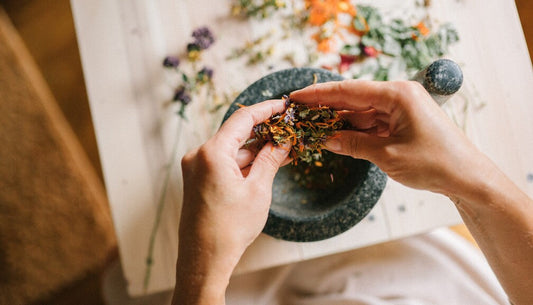In Ayurveda the fall season corresponds to two major doshas or mind-body principles: Pitta and Vata. (Learn more about doshas here.) Autumn is considered Pitta as long as hot weather prevails, and Vata as it becomes cold. Late fall and winter are known as “Vata season” because they are marked by some of the same qualities that characterize Vata: cold, dry, light, clear, and moving.
As long as these qualities are in balance, a person whose dosha is predominantly Vata will be healthy, creative, and exuberant. But when too much Vata accumulates in the body and mind, the imbalance may manifest as physical or emotional disorders, including insomnia, dry skin, arthritis, constipation, high blood pressure, anxiety, and depression.
All body types are vulnerable to Vata derangement during autumn and winter, but those who are predominantly Vata types need to be particularly vigilant about staying in balance. If you don’t know your dosha, take the Dosha Quiz here.
Here are some practical ideas to keep you grounded and vibrant during the cold months ahead in the Northern Hemisphere. For those readers living in the southern half of the planet, spring and Kapha season have arrived, so you will need to focus instead on keeping the earth and damp qualities of Kapha dosha in balance. Read Kapha balancing suggestions here.
Follow a Vata-pacifying Diet
As you weave these Vata-balancing practices into your life, remember that Vata thrives on regularity and routine. This includes getting up and going to bed at about the same time every morning and evening; eating meals on a predictable schedule rather than “grazing” or skipping meals or eating on the run; and planning time each day for exercise, rest, and relaxation. As you create a daily balancing routine that nourishes your mind, body, and spirit, you will find yourself feeling more energized and centered in the months to come.
Feeling out of balance? A gentle Ayurvedic cleanse can help you reset your mind-body and return you to baseline. Learn more.
As long as these qualities are in balance, a person whose dosha is predominantly Vata will be healthy, creative, and exuberant. But when too much Vata accumulates in the body and mind, the imbalance may manifest as physical or emotional disorders, including insomnia, dry skin, arthritis, constipation, high blood pressure, anxiety, and depression.
All body types are vulnerable to Vata derangement during autumn and winter, but those who are predominantly Vata types need to be particularly vigilant about staying in balance. If you don’t know your dosha, take the Dosha Quiz here.
Here are some practical ideas to keep you grounded and vibrant during the cold months ahead in the Northern Hemisphere. For those readers living in the southern half of the planet, spring and Kapha season have arrived, so you will need to focus instead on keeping the earth and damp qualities of Kapha dosha in balance. Read Kapha balancing suggestions here.
Follow a Vata-pacifying Diet
- Eat foods that are warming, fresh, and well cooked; avoid dry or uncooked foods (especially salads and raw fruits and vegetables).
- Drink lots of warming liquids such as hot water and herbal teas to prevent dehydration. You can prepare a fresh ginger tea by placing a teaspoon of fresh grated ginger into a pint thermos bottle and filling it with hot water. You may also enjoy the Chopra Center’s organic Relaxing Tea, made with herbs that balance the Vata dosha.
- Eat more of the sweet, sour, and salty tastes and less of the bitter, astringent, and pungent ones. Avocados, bananas, mangoes, peaches, lemons, pumpkins, carrots, beets, asparagus, quinoa, rice, mung beans, almonds, sesame seeds, and ghee are a few excellent Vata-pacifying foods.
- Don’t worry if your appetite seems stronger than usual as this is a natural tendency in winter and helps pacify Vata. At the same time, of course, don’t eat to the point of discomfort.
- Wear clothing made with soft fabrics in earth tones and mild pastel shades, which calm Vata.
- Stay warm. Vata is a cold, dry dosha, so it’s important to make sure that your home and work place are well heated and that the air has enough humidity. Since Vata is extremely sensitive to moving air, it’s wise to avoid drafts or sitting near fans or ventilators.
- Give yourself slow, gentle self-abhyanga massage in the morning or before bed. Use a nourishing, warming oil such as sesame or almond. You may also want to gently rub a drop of sesame oil inside your nasal passages, which tend to become dry during winter.
- Get enough sleep! This is vital for Vatas, who tend to push themselves to the point of physical or mental exhaustion. Read more about creating a restful sleep routine here. Good rest is vital to balance.
- Learn to meditate. For the overactive Vata mind, meditation is one of the best ways to find calm and stillness.
As you weave these Vata-balancing practices into your life, remember that Vata thrives on regularity and routine. This includes getting up and going to bed at about the same time every morning and evening; eating meals on a predictable schedule rather than “grazing” or skipping meals or eating on the run; and planning time each day for exercise, rest, and relaxation. As you create a daily balancing routine that nourishes your mind, body, and spirit, you will find yourself feeling more energized and centered in the months to come.
Feeling out of balance? A gentle Ayurvedic cleanse can help you reset your mind-body and return you to baseline. Learn more.






















